When the Firkin Flows–Why cask ale is like Heidi Klum, chicken wings, and not at your pub
Words: Ted McCartan
Photos: Don Osborn & Geoff Cozine
Issue: March/April 2009 (Issue 9)
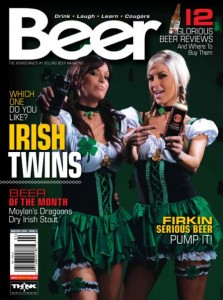
Other than, say, an aquarium full of lobsters, most restaurants don’t carry live products. Makes sense. One could imagine the potential problems that could arise if chefs had to chase down Foghorn Leghorn during the dinner rush. It would create an awful lot of extra work, and of course the potential for an ever-looming worker’s comp lawsuit, what with chefs running and hacking at a chicken’s neck and all.
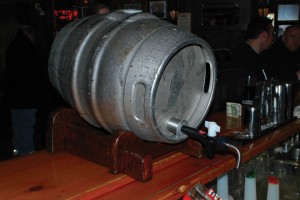
It’s Alive
So it’s no wonder that most good beer bars in the United States don’t carry living ale. After all, beer that is “alive,” or cask-conditioned, takes more work than your traditional kegs. But some brewpubs and great beer bars do carry the beer style that many gurus describe as the only way to truly taste the full richness and flavor in a brew. The lightly-carbonated beverage goes through a secondary fermentation in the keg, which is usually of the British variety called “firkins.” This is how the beer is technically still alive, because yeast is actively still converting sugars into alcohol. As with all brewing processes, carbon dioxide is naturally created, but unlike all other kinds of draught beer, no additional gas or CO2 is pumped into the barrel or lines to dispense it. Instead, the bartender uses a hand pump and a beer engine that brings the beer through the lines and to the pint. It takes a bit of familiarity between the bartender, the brew, and the hand-pull, as every barrel is a bit different. After at least two pumps, the result is a beer with carbonation that won’t spiral around the glass like a snow globe, and will barely be noticeable by sight and won’t over-tickle the taster. The beer’s head will appear with distinct bubbles gathered and bunched atop a bright, clear liquid, ideally peaking above the edges of the pint glass. Due to it not being filtered or pasteurized, the beer may be cloudy at first, but most will settle with clarity after maybe 30 seconds. And it should be about 15 degrees higher in temperature than the cellar temperatures customers are used to. The higher temp, coupled with the lightness of the carbonation, sometimes saddle the brew with an unfair description as warm and flat. But that is like describing a buffalo wing as chewy and messy, or Heidi Klum as lanky and lumpy. You’re misconstruing the best qualities with negative descriptions. A cask-ale drinker describes his pint as cool and lightly-carbonated, so the flavors of each ingredient are emphasized, just as he would relish a buffalo wing for its fun mess and admire Klum’s long legs and lovely lady lumps, as Fergie would so eloquently call them.
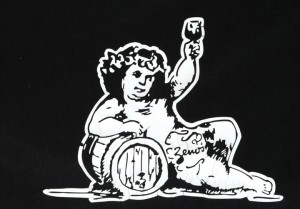
Who drinks it?
It’s the beer style that old English men, some of the oldest, truest, and most serious beer drinkers, revere like Chicagoans do their deep dish pizza and defend it the way football pundits do Brett Favre. “That’s real beer,” they say. “No chemicals. The way it was meant to be.”

World War II nearly saw the end of this old school style of ale in the United Kingdom, as cask conditioning gave way to larger corporate breweries. However, it’s been making a comeback in the last few decades. Campaign for Real Ale, or CAMRA, is an organization committed to restoring the place of cask-conditioned ale at the pub. Real ale sales have been resilient in the UK, according to Dan Fox, manager of The White Horse on Parsons Green, perennially ranked one of the best beer pubs in London. WWII’s end brought the mega brands of beer stateside, though their commercials pack more flavor and fun than their products. Only recently with the popularity of microbreweries has cask-conditioned reclaimed a place on the beer drinker’s palate. According to a New York Times article, one large craft beer distributor’s cask accounts rose over 300% from 2005-2007. Great beer bars in other major markets offer the variety, and most microbreweries offer their brands in casks either at their own brewpubs or distributed to the right occasion or venue.
Where the Firkin are They?
Wil Turner has been the pub brewer for the Goose Island Brew Pub in Chicago for over six years. Turner learned the proper brewing and care techniques of fine ale and cask-conditioned beer while working for a brewery in England. He remembers personally hand-delivering firkins to bars and pubs around the Windy City in the company Explorer. Streamlined distribution strategies have made this old school delivering obsolete for GI, but Chicago’s premiere microbrewery consistently has at least one beer on one if its three hand-pull taps at the brew pub on Clybourn, and hosts an annual cask-conditioned beer festival entitled The Night of the Living Ales at the Wrigleyville pub.
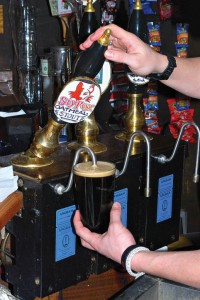
Similarly to Goose Island, the Bridgeport Brewery in Oregon does its craft beer in casks, and has done so for over 20 years. “One of the first things we tried to get for the brewpub was some cask beer engines,” said Karl Ockert, Brewmaster for Bridgeport Brewery, Oregon’s first microbrewery. The equipment wasn’t easy to get, but his cask ales caught on quick with an ex-patriot British crowd, and Bridgeport still does up to three at the brewpub at any given time. Ockert was first introduced to real ale while in London and prefers it himself. Bridgeport brews upwards of nine firkins a week and Ockert likes to have more than one for his customers.
“It’s a niche kind of thing,” he said. “It’s not the cold, clear, carbonated beer that Americans are used to. I try to push it as often as I can. You can taste the ingredients a
lot better.”
Sierra Nevada brews over 700,000 barrels a year, and cask accounts for less than one percent of that. However, like GI they have a cask on every Thursday night at their brewpub, and Communications Coordinator Bill Manley says that any of their brands
may make an appearance in a cask.
“It’s not a pain for us; we pretty much brew cask for as much as the demand calls,” he says. “It just takes a little bit of foresight. You have to figure out which fermenter, which beer is in the right stage of its life cycle at a given time, and whether you have firkins clean and ready to go.”
Firkin TLC
On-premise care for casks usually requires special training for bartenders and staff. According to Turner, not enough bars without ties to breweries do it properly. Ockert agrees, and says Bridgeport exercises caution when distributing firkins. “We typically don’t sell our firkins to other bars because the distributors and the pubs don’t know how to deal with it.”
Furthermore, the general structure and functionality of the American beer bar isn’t conducive to cask. There are almost too many choices, and cask ale that sits more than three days is at risk of becoming skunky.
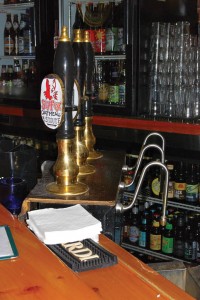
“Places that cater to the huge beer drinker in the States, the consumer who would be interested in cask, offer so many products,” explains Manley. “Great beer bars generally have over 50 taps, over 100 bottles, and just one cask among all those choices could have trouble moving.”
The result then is a keg of bad cask-conditioned beer that has to be poured out, clearly not the desired outcome for a
pub owner.
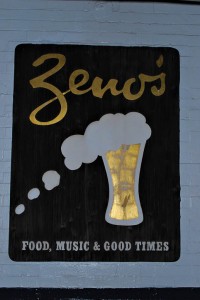
Firkin Success Story
There are pub managers who make it their priority to prevent that result. Jay Jankowki is the Manager of The Map Room in Chicago, which has a cask beer on nearly all the time. In early December Jankowski pulled Three Floyd’s Pride and Joy, one of his top sellers, through the beer engine. “What I’ve seen, if you don’t clean the line, it doesn’t taste good,” Jankowski says. “And then the product is misrepresented. Managers have to be dedicated to proper maintenance.” Jankowksi’s personal point of pride? English brewing staple Fuller’s shipped a few firkins to The Map Room, and staff from the brewery came to sample it on site and came to the conclusion that it tasted better in Bucktown than it did in Britain. Cheers to that.
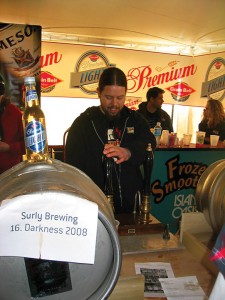
And there’s a local feel to it at The Map Room. The rack its cask sits on was made by a regular, and the pub uses its status to educate and inform its clientele about all beers, cask included. Dan Beringhele, a 31-year-old home brewer was first introduced to cask at the Map Room. He was enjoying a pint of Pride and Joy and said simply that if something he likes is on cask, he’ll get it. “I think cask is better,” he says. “I don’t like carbonation.” Likewise, Naja’s Place in Redondo Beach, California is a well-renowned beer bar. Naja’s is planning to install cask racks that will rest within the bar, covered by an ice blanket to stay at the appropriate temperature. Matt Thomas is the longest tenured bartender for the beachside beer bar, which has 88 draft beers in addition to its bottle selection. “We have people that specifically come asking for cask-conditioned beer,” he says. “It sells well. It is a small segment of the market but when it is available you can’t stop pouring it.”

Firkin Overtaking the World?
So when it’s on, it sells. And shipping isn’t a huge issue—Fuller’s brought kegs from London to Chicago, and Fox had casks from Flying Dog Brewery, Anchor Brewery, and Sierra Nevada at The White Horse’s first annual American Beer Festival this past July. But the future for cask ale appears to be similar to its current place in the market, unless Anheuser Busch or other breweries with deep pockets dump money into a vast marketing and training campaign. Couldn’t some blonde bombshell pump ale from a hand-pull ever-so-sensually to make it appealing to the non-enlightened drinker? Or could cask ale brewers learn from Guinness, which made training trendy by emphasizing that it takes 119.5 seconds to pour a proper pint? Probably not. Budweiser has its millions of drinkers who like their king of beers just fine, and while Guinness may require more time to pour, it doesn’t require the bar to purchase expensive beer engines to do so. Even the Map Room turns little profit on its cask ale; at five dollars a pint, it carries it just to offer its distinguished beer clientele a broad spectrum of products.
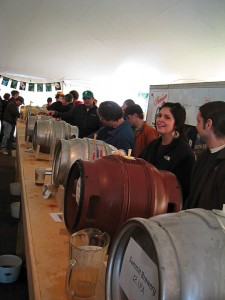
“I don’t see it getting larger than 5-10 percent,” Thomas said. “It’s so much more difficult to handle. It’s hard to do large amounts and treat it with the respect that is necessary.”
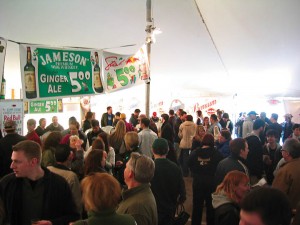
Ockert, the brewmaster, agrees. “It’s kind of hit or miss,” he says. “But it sure is good when you find it.”
So cask ale drinkers are left with little to do, really, other than drink lots wherever they find the firkin flowing, and envy those lobster fans like crazy.




